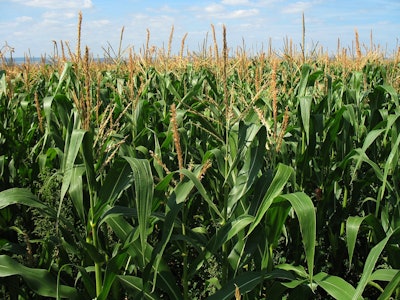
The USDA's July World Agricultural Supply and Demand Estimates (WASDE) report revealed producers will harvest massive crops of both corn and soybeans this year, boosting the supply base despite drought conditions stressing plants during early stages of development.
Reuters reports the unexpectedly large forecasts immediately pushed down corn and soy futures, potentially easing inflation and making U.S. exports more competitive with South America in coming months.
July's WASDE noted the corn harvest was predicted at a record large 15.3 billion bushels and soybean harvest at 4.3 billion bushels.
High prices have curtailed export demand for both corn and soybeans, with overseas buyers preferring less expensive grain from Brazil due to its massive harvest.
USDA cut its outlook for U.S. soybean exports in the 2023/24 marketing year to 1.850 billion bushels from 1.975 billion.
- Soybean ending stockpiles of 300 million bushels, up 45 million bushels from 2022/23 and above the high end of market expectations
- Corn ending stocks for 2023/24 at 2.262 billion bushels, 5 million bushels higher than its June outlook
WHEAT: Changes this month to the 2023/24 U.S. wheat outlook increase supplies and domestic use, leave exports unchanged, and increase ending stocks.
Supplies are raised on larger production, which is up 74 million bushels to 1,739 million, on higher harvested area and yields. The first 2023/24 survey-based production forecast for other spring and Durum indicates a decrease from last year. Conversely, winter wheat production is forecast higher on larger harvested area and higher yields.
Gains for all wheat production are partly offset by smaller beginning stocks, which are lowered 18 million bushels to 580 million as indicated in the Grain Stocks report, issued June 30. The 2023/24 ending stocks are forecast at 592 million bushels, 30 million higher than last month.
- The projected season-average farm price is forecast at $7.50/bushel, down $0.20 from last month.
This month provides the first by-class 2023/24 U.S. wheat supply and use projections. Two consecutive years of drought-affected Hard Red Winter (HRW) wheat crops reduce HRW ending stocks to the lowest level in 16 years despite decreased total use. HRW food use is forecast to be the smallest since 2010/11, while HRW exports are the lowest since by-class supply and utilization records began in 1973/74.
Updates to the 2023/24 global wheat outlook reduce supplies, increase consumption, lower exports, and decrease stocks compared with last month.
Supplies are reduced 0.9 million tons to 1,066.0 million as lower global production is partially offset by larger beginning stocks. Production is reduced primarily for the EU, Argentina, and Canada, and is only partially offset by increases for the U.S. and Pakistan. EU production is lowered 2.5 million tons to 138.0 million, as ongoing dry weather diminishes yield prospects primarily in Germany, Spain, France, and Italy. The forecast for Argentina wheat production is decreased 2.0 million tons to 17.5 million based on revised government estimates of planted area.
Dry conditions in parts of Alberta and Saskatchewan lowers production for Canada 2.0 million tons to 35.0 million. Global trade is projected down 1.0 million tons to 211.6 million as lower exports from Argentina and Canada are only partially offset by more exports from Russia. World consumption is raised 3.3 million tons to 799.5 million, primarily on increased feed and residual use in China where rains at harvest, especially in Henan province, degraded wheat quality for food use. Projected 2023/24 world ending stocks are lowered 4.2 million tons to 266.5 million and would be the fourth consecutive annual decline.
COARSE GRAINS: This month’s 2023/24 U.S. corn outlook is for fractionally higher supplies and ending stocks.
Corn beginning stocks are lowered 50 million bushels, as greater feed and residual use for 2022/23 more than offsets reductions in corn used for ethanol and exports. Corn production for 2023/24 is forecast up 55 million bushels as greater planted and harvested area from the June 30 Acreage report is partially offset by a 4.0-bushel reduction in yield to 177.5 bushels/acre.
According to data from the National Centers for Environmental Information, harvested-area-weighted June precipitation data for the major Corn Belt states represented an extreme downward deviation from average. However, timely rainfall and cooler than normal temperatures for some of the driest parts of the Corn Belt during early July is expected to moderate the impact of June weather. For much of the crop the critical pollination period will be in the coming weeks. With supply rising fractionally and use unchanged, ending stocks are up 5 million bushels.
- The season-average farm price received by producers is unchanged at $4.80/bushel.
Global coarse grain production for 2023/24 is forecast 0.1 million tons higher to 1,513.4 million. This month’s 2023/24 foreign coarse grain outlook is for lower production and use, and slightly smaller stocks relative to last month.
Foreign corn production is fractionally higher with area increases for Canada and Ukraine that are partially offset by an area reduction for the EU. For 2022/23, corn production is raised for Brazil but lowered for Argentina based on harvest results to date. Foreign barley production for 2023/24 is lowered with cuts for the EU and Ukraine partly offset by increases for Argentina and Morocco.
Major global trade changes for 2023/24 include larger corn exports for Ukraine, with greater imports for the EU. For 2022/23 corn exports are higher for Brazil but are lowered for Argentina for the local marketing year beginning March 2023. Corn exports are also raised for Ukraine, Russia, and the EU but reduced for the United States and India. Barley exports for 2023/24 are lowered for the EU and Ukraine but increased for Argentina. China’s barley and sorghum imports are increased. Foreign corn ending stocks are virtually unchanged relative to last month. Global corn stocks, at 314.1 million tons, are up 0.1 million.
OILSEEDS: U.S. oilseed production for 2023/24 is projected at 127.6 million tons, down 5.6 million from last month with reductions for soybeans and sunflowerseed, partly offset by higher canola and peanuts.
Soybean production is projected at 4.3 billion bushels, down 210 million on lower harvested area. Harvested area, forecast at 83.5 million acres in the June 30 Acreage report, is down 4.0 million from last month. The soybean yield forecast is unchanged at 52.0 bushels per acre. With lower production partly offset by higher beginning stocks, 2023/24 soybean supplies are reduced 185 million bushels. Soybean crush is reduced 10 million bushels reflecting a lower soybean meal domestic disappearance forecast. Soybean exports are reduced 125 million bushels to 1.85 billion on lower U.S. supplies and lower global imports. With lower supplies only partly offset by reduced use, ending stocks for 2023/24 are projected at 300 million bushels, down 50 million from last month.
- The U.S. season-average soybean price for 2023/24 is forecast at $12.40/bushel, up $0.30 from last month.
- The soybean meal price is projected at $375/short ton, up $10.
- The soybean oil price forecast of 60 cents/pound is up 2 cents.
The Environmental Protection Agency (EPA) issued the final renewable fuels standards rule for 2023, 2024, and 2025. The 2023 biomass-based diesel volume mandate was unchanged from the proposal published last December. For 2024, EPA increased the non-cellulosic advanced biofuel volume mandate but lowered the implied conventional volume.
USDA assumes that biomass-based diesel would be produced in excess of the advanced biofuel volume mandate to make up the shortfall in conventional renewable fuel to meet the total renewable fuel obligation. With the offsetting changes compared to the proposal in 2024, there is no change to soybean oil used for biofuel for 2023/24 this month.
Foreign oilseed production is increased 1.5 million tons to 539.7 million on higher sunflowerseed, soybean, and rapeseed production. Sunflowerseed and rapeseed production is raised for Ukraine reflecting higher area in government planting progress reports. Soybean production is increased for Canada based on the latest plantings report from Statistics Canada. Partly offsetting is lower rapeseed production for the EU, down 0.8 million tons to 20.2 million based on dry conditions especially in France and Germany.
Global soybean trade for 2023/24 is down 3.1 million tons to 169.3 million as reduced U.S. exports are paired with lower imports for China, Egypt, Bangladesh, Pakistan, Turkey, and Thailand. China’s imports are lowered 1.0 million tons to 99.0 million due to higher carryin supplies from increased imports in the prior marketing year. Global soybean ending stocks are reduced 2.4 million tons to 121.0 million mainly on lower U.S. stocks.
















